
Integrating the PLA Rocket Force into Conventional Theater Operations
Publication: China Brief Volume: 20 Issue: 14
By:
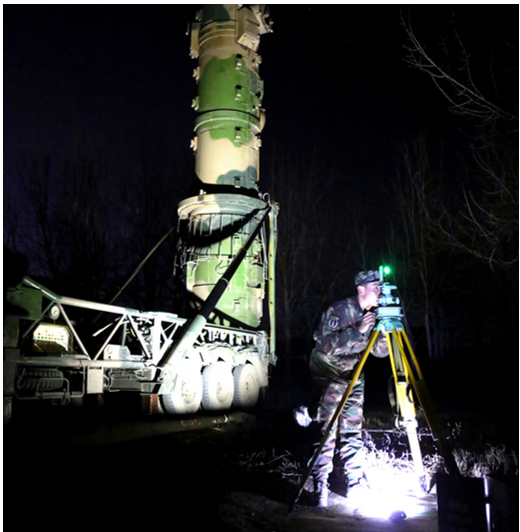
Introduction
Currently, only limited analytical discussion exists regarding the command authorities over China’s land-based ballistic and cruise missile inventory. Much of the discourse surrounding the People’s Liberation Army Rocket Force (PLARF)—the military service that operates most of China’s land-based precision strike systems—focuses on nuclear command and control. Further discussions regarding the PLARF’s conventional land-based ballistic and cruise missile systems are limited, and make only vague references as to how the PLA is working to integrate PLARF units into the theater command structure—without going into detail about the major obstacles that preclude full integration of the PLARF.
This article makes the case that PLA theater commands almost certainly have clearly defined operational control authorities over some of the PLARF’s conventional missile force. This conclusion is based on the evidence of command authorities granted to certain PLARF bases; the integration of missile operations into theater joint operations command structure; and indications from PLA press outlets that PLARF units are subordinate to the theater command operational structure.
Understanding the Difference Between Administrative and Operational Control
This section briefly discusses how the PLA conceptually exerts administrative and operational control over its forces. Figure 1 broadly displays how the PLA oversees issues relating to manning, training, and equipment. It is also more closely aligned with what most observers traditionally associate with the PLA’s organizational structure.
Figure 1: The PLA’s Administrative Organization Chart
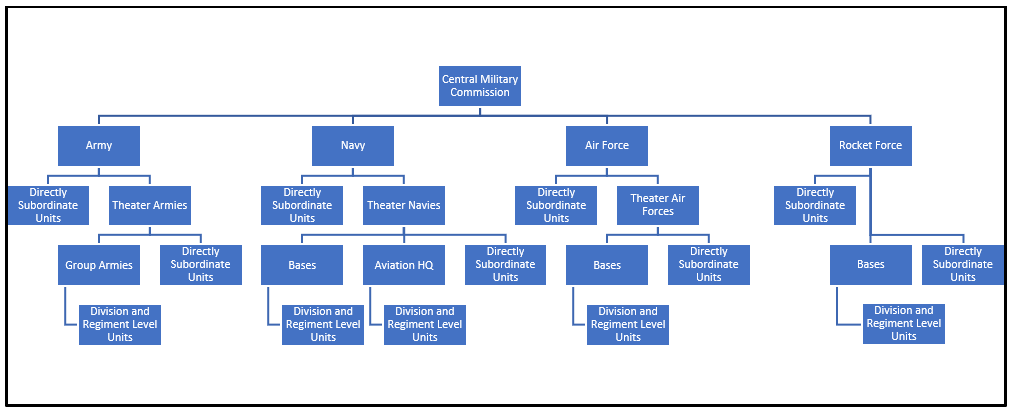
However, the PLA’s organizational hierarchy looks a little different when it comes to operations. Figure 2 displays the operational chain of command, as well as the primary command node at each level.
Figure 2: Operational Command in the PLA
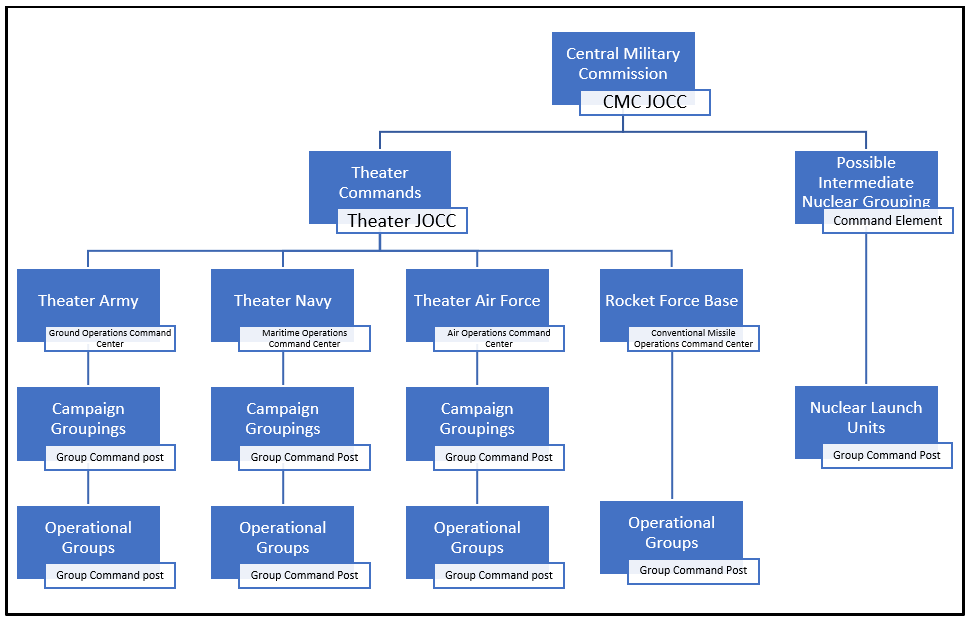
Although there are many similarities between the PLA’s administrative and operational chains of command, they are not identical. Notably, the PLA uses elements of standing division and regiment-level organizations to create temporary operational and tactical groupings, termed jituanqun (集团群), biandui (编队), and qun (群). This means that in practice, units that report to the same higher administrative headquarters may report to two different operational commands.
Empowering PLARF Bases
As seen in Figure 2, the PLARF does not have a theater service headquarters at each of the theater commands, as the PLA’s other services do. This apparent lack of theater service headquarters leads to some confusion as to how PLARF units are integrated into theater operations. This confusion is resolved by understanding that PLARF bases appear to fill a role similar to that of theater service headquarters. PLARF bases are corps or corps deputy-grade organizations that are responsible for geographic or functional areas. [1] In addition to providing administrative oversight for PLARF units under its command, a PLARF base with missile launch units also acts as the PLARF’s primary campaign-level organization (基本战役单位, jiben zhanyi danwei) in wartime. This means that PLARF bases are expected to conduct conventional missile strike campaigns independently or as part of a larger joint campaign. [2]
In order to enable PLARF bases to leverage joint forces when executing a conventional missile strike campaign, the PLA designates at least some PLARF base joint operation duty offices as “theater conventional missile sub-command centers,” according to authoritative PLA press from late 2017. [3] This nomenclature makes a clear connection between the theater commands and PLARF bases. Not only do these bases exert operational control over conventional missiles on behalf of the theater command, but these bases also have the authority to coordinate operations with army, navy, and air force units.
Theater Rocket Forces
In addition to designating some PLARF bases as “theater conventional missile sub-centers,” the PLA also envisions PLARF bases as being roughly analogous to theater services headquarters. They also maintain their own subordinate forces. Limited press and social media reports suggest that the PLA identifies certain PLARF units as “theater command PLARF units” (战区火箭军某部, zhanqu huojianjun moubu). This designation suggests that the PLA gives certain PLARF units a status analogous to that of army, navy, or air force theater-level command nodes within the theater command structure.
At the corps level, the Eastern Theater Command (and possibly other theater commands) identify PLARF bases as theater service component equivalents. The following image from a CCTV-7 series on the PLARF depicts how the Eastern Theater Command generates combat power:

This image indicates that Rocket Force bases are equivalent to theater services and contribute directly to theater command combat power. Corroborating this graphic is the fact that an Eastern Theater Command social media account also regularly reports on Number 61 Base, suggesting that this base falls under the theater command structure (Eastern Front View (Weixin), November 13, 2018).
At the tactical level, various PLA press sources identify multiple PLARF units as being “theater PLARF units.” To date, PLA social media has identified at least five different PLARF units across three separate PLARF bases as “theater PLARF units,” as shown below:
Figure 3: Identified Theater-Level PLARF Units in the Eastern and Southern Theater Commands
| Unit | Equipment | Theater |
| 612th Launch Brigade | DF-21A (probable) | Eastern Theater Command |
| 617th Launch Brigade | DF-15/16 | Eastern Theater Command |
| 61 Base Training Regiment | N/A | Eastern Theater Command |
| 623rd Launch Brigade | CJ-10 | Southern Theater Command |
| 635th Launch Brigade | CJ-10 | Southern Theater Command |
Source: Compiled by the author.
Unauthoritative PRC press sources have also identified PLARF units subordinate to the Northern, Central, and Western Theater Commands. This small list of PLARF units under theater commands suggests that launch brigades equipped with short range ballistic missiles (SRBMs) and ground launched cruise missiles (GLCMs) fall under the theater command. Assuming that the trend of PLARF SRBM and GLCM units being subordinate to the theater command holds true for the entire force,
Figure 4: Locations of Other Known SRBM and GLCM Launch Brigades in the Eastern and Southern Theater Command Areas of Responsibility
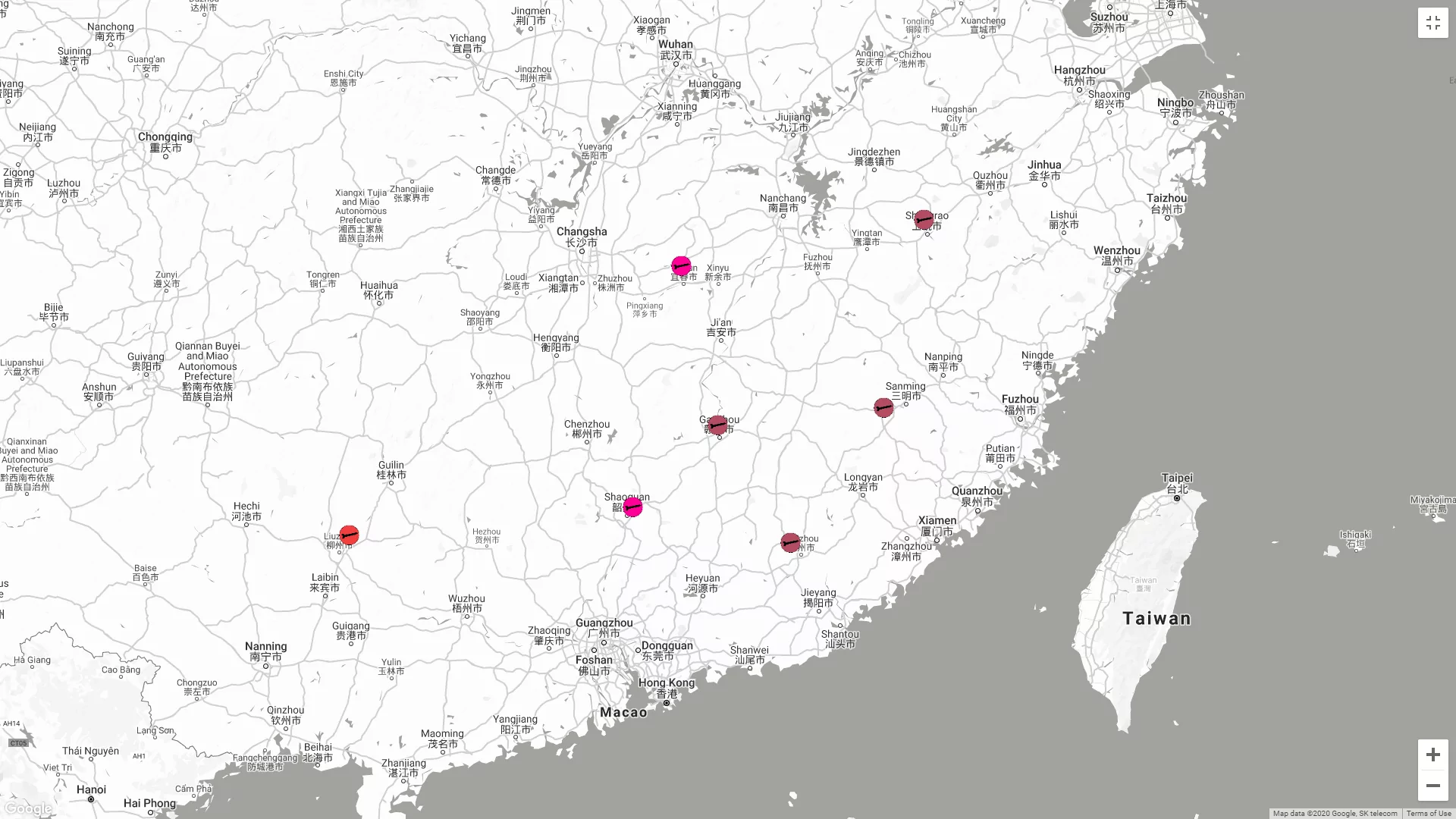
Notably, with the exception of a single DF-21A unit, all of the units identified by PLA social media as being a theater PLARF unit are conventional in nature, with a range limited to roughly the First Island Chain. The single Eastern Theater Command-based DF-21A unit may also be an exception due to mission and warhead limitations. Extrapolating from this small data set could suggest that the PLA withholds theater command access to conventional systems that are intended for strategic targets—such as the DF-21D or DF-26—in addition to nuclear-only systems such as intercontinental ballistic missiles (ICBMs).
Why Is There No “Theater Rocket Force”?
The rationale behind the PLA not designating PLARF bases as “theater rocket forces” is likely a result of the PLARF’s relatively small force size. Theater armies, navies, and air forces control two or more corps-level entities. Those corps-level entities in turn oversee more than half a dozen division or brigade level organizations. In total, a theater service headquarters could oversee 20 or more division or brigade level organizations either directly or indirectly.
PLARF launch bases, on the other hand, oversee approximately six launch brigades and six support regiments. Half of the launch bases oversee the administration of primarily nuclear-equipped ICBM units, which most likely are under the direct operational control of the Central Military Commission. This means that PLARF launch bases only have a fraction of the responsibility of larger theater service headquarters. As such, it makes little sense for the PLA to form fully-fledged rocket force headquarters at the theater command level.
Integrating Conventional Missile Operations at the Theater Commands
Given that most conventional missile strike campaigns are to be executed as part of a larger joint campaign, the theater commands must also have an organic capability to plan and execute conventional missile operations. Theater commands have accomplished this by providing theater command staff with officers who have a PLARF background, as well as command information systems that have the functionality to pass commands to conventional missile units.
In order to help integrate and execute missile operations as part of a larger joint campaign, some if not all theater commands have dedicated PLARF staff officers. For example, Southern Theater Command (STC) deputy chief of staff Tan Jianming (谈建明) is a career PLARF officer (Southern Daily, December 5, 2018; Peng Pai News, July 29, 2017). He previously served in various capacities at Base 63 (formerly Base 55), which is a unit well positioned to support STC operations. It is not unreasonable to assume that other theaters also have a PLARF officer serving in similar capacities. Theater-level joint operations command centers (JOCCs) also have dedicated “conventional missile seats” from which staff officers can direct missile operations (Xinhua, January 7, 2018).
In order to execute the plans developed by PLARF staff officers in theater commands, and to oversee conventional missile operations conducted in support of theater joint campaigns, at least some theater commands may have technical systems in place to pass commands to PLARF units.
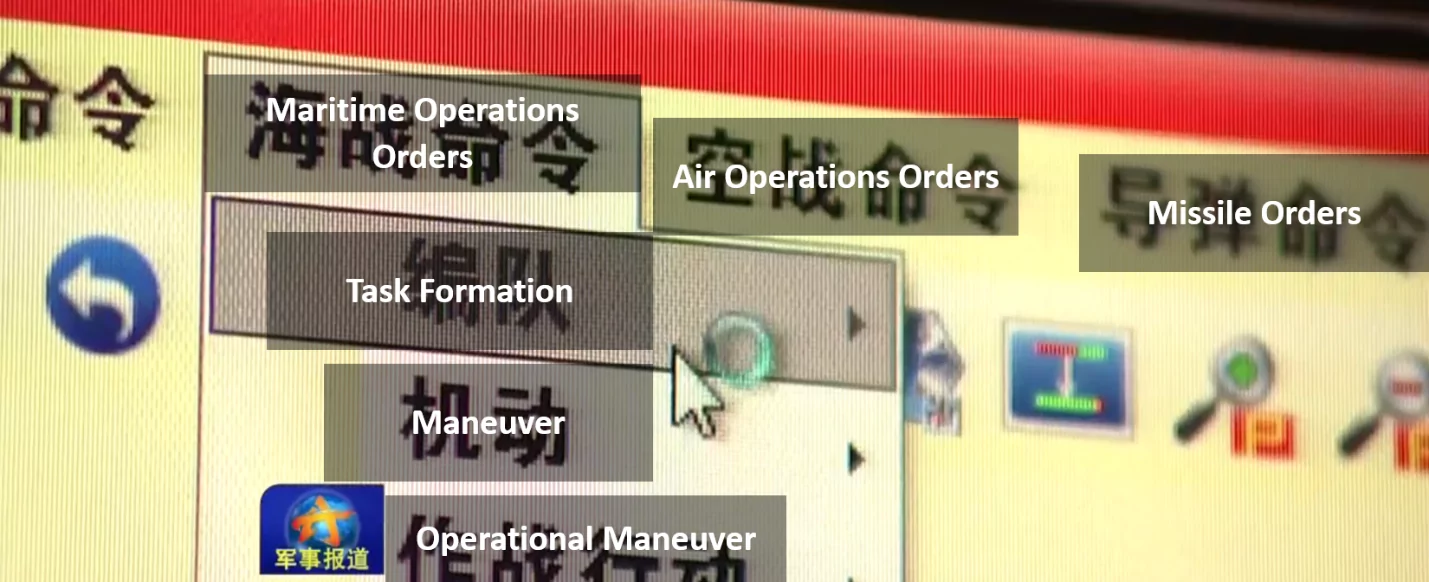
Conclusion
Although units capable of both nuclear and conventional missions may pose some challenges for command and control, these difficulties are almost certainly overstated. The PLA’s administrative organization does not perfectly reflect how the PLA is organized for operations. Conceptually, PLARF units can task organize into operational and tactical groups during crises or wartime, just like any other service. Although a nuclear-capable PLARF missile brigade may be administratively subordinate to a base acting as a theater command conventional missile sub-center during peacetime, under warfighting conditions that missile brigade will simply be assigned to a CMC-controlled operational group.
It appears that the PLA has taken appropriate steps to empower the theater commands by providing clearly defined operational authorities over some, if not most, PLARF conventional missile units. Although PLARF base boundaries do not perfectly match theater geographic boundaries, the PLA has clearly defined command relationships between the two. Furthermore, the PLA has empowered the theater commands with resident expertise in the form of dedicated PLARF staff officers. This provides theater commanders with what is almost certainly a major component of their regional land attack capability.
The apparent command relationship between theater commands and certain PLARF units has several implications for the United States and its regional partners. First, U.S. and partner nation planners should treat theater command PLARF units as valid targets that do not pose significant additional risks for nuclear escalation. One of the points of contention in Western discourse is that the PLARF’s integration of conventional and nuclear forces complicates targeting: this is because any destruction of a PLARF unit may be perceived by the PLA as a step towards nuclear escalation. However, because the PLA has publicly identified certain units as not falling under the direct authority of the CMC, the United States and its partners should not treat these PLARF units any differently than a PLA fighter brigade or combined arms brigade.
Second, this knowledge should be used as a starting point of discussion with the PLA on issues related to escalation. A clear understanding of conventional versus nuclear command and control in the PLA at the operational and tactical level allows interlocutors to move beyond PLA attempts to stonewall conversations through claims that the opposing side simply does not understand the PLA. This in turn provides a greater chance of clarifying which PLARF units the PLA will allocate to nuclear and strategic missions.
Roderick Lee is the Director of Research at the Air University’s China Aerospace Studies Institute (CASI), where he oversees research on Chinese military aerospace forces and the Chinese civilian aerospace sector as it relates to the military. Prior to joining CASI, he served as an analyst with the United States Navy covering Chinese naval forces. He earned his Master of Arts degree from The George Washington University’s Elliott School of International Affairs. The views expressed here are his own, and are not intended to represent those of the Air University or any other U.S. government institution.
Notes
[1] See: ‘PLA Aerospace Power: A Primer on Trends in China’s Military Air, Space, and Missile Forces’ 2nd ed., China Aerospace Studies Institute (CASI), 2019, https://www.airuniversity.af.edu/Portals/10/CASI/Books/Primer_2nd_Edition_Web_2019-07-30.pdf.
[2] See: ‘Science of Campaigns [战役学],’ ed. Zhan Yuliang (张玉良), 2nd ed., Beijing: National Defense University Press (国防大学出版社), 2006.
[3] See: “PLA Rocket Force Follows Reform Process and Further Advances Realistic Combat Training,” [火箭军部队紧跟改革进程深入推进实战化训练], Han Xinbang (韩兴邦), Liu Ya (刘亚), Rocket Force News [火箭军报], November 15, 2017.
[4] See: CCT-7 Military Report 30 January 2018[ 军事报道 20180130], CCTV-7, January 30, 2018.




